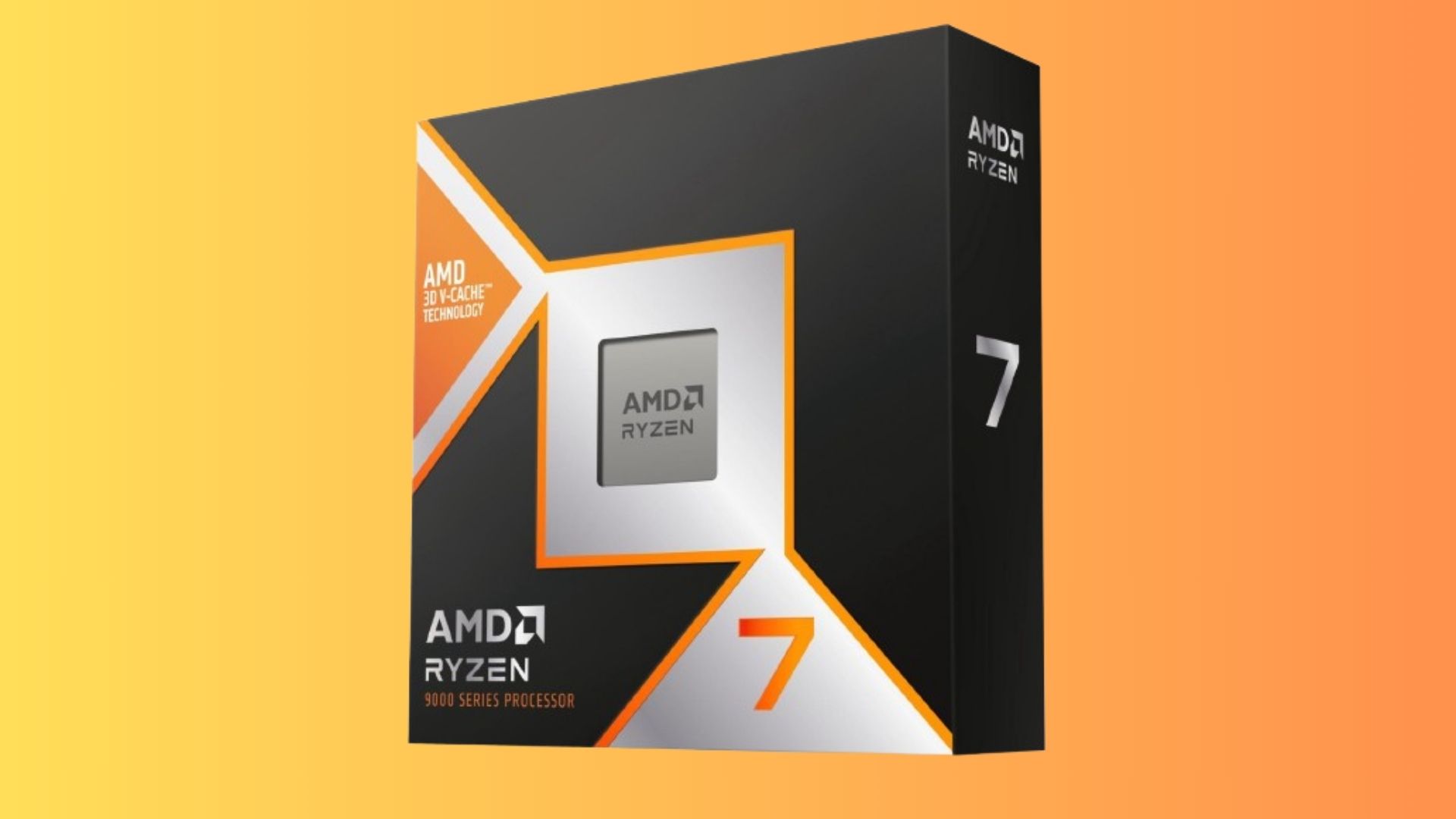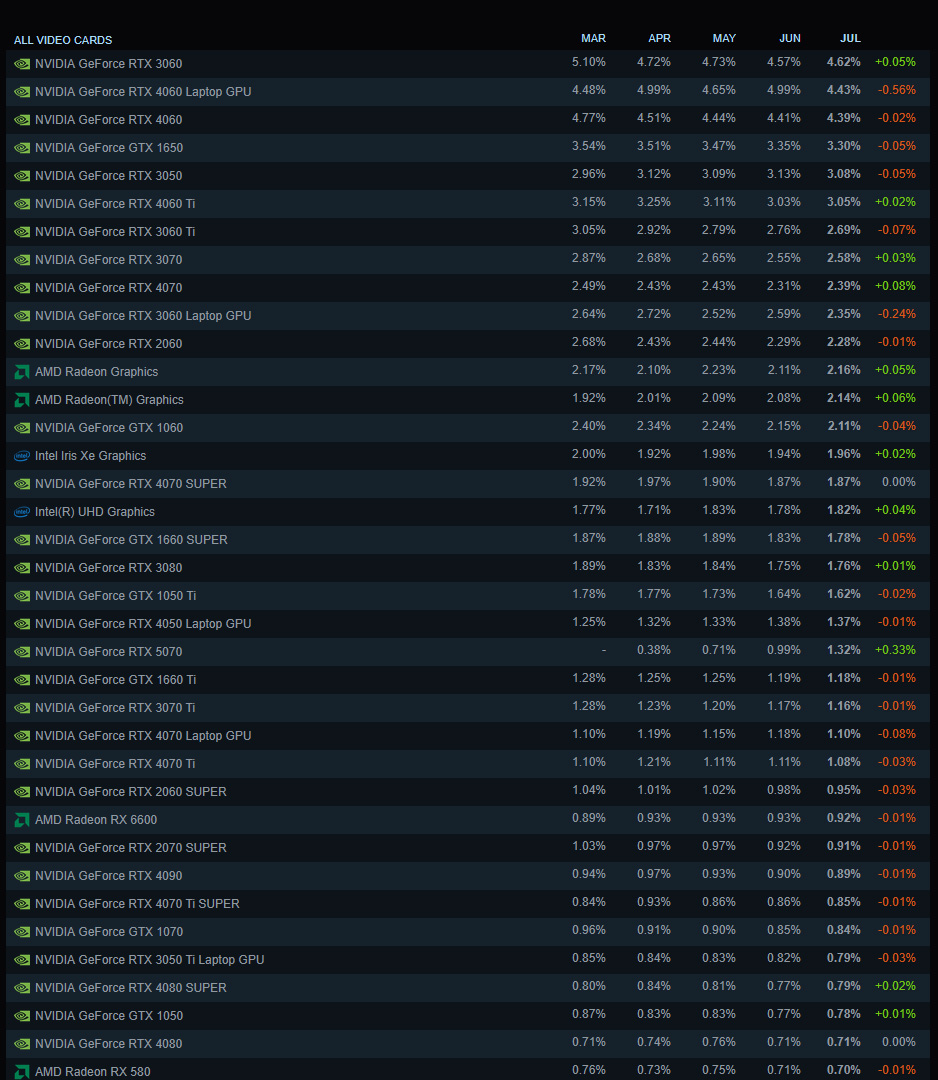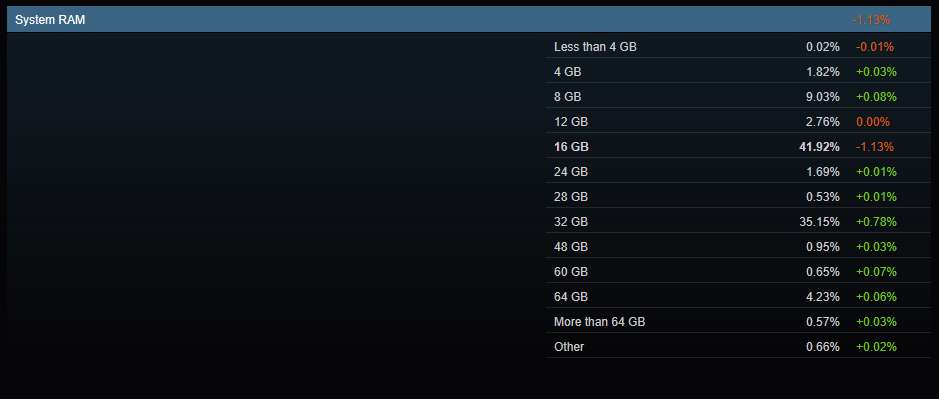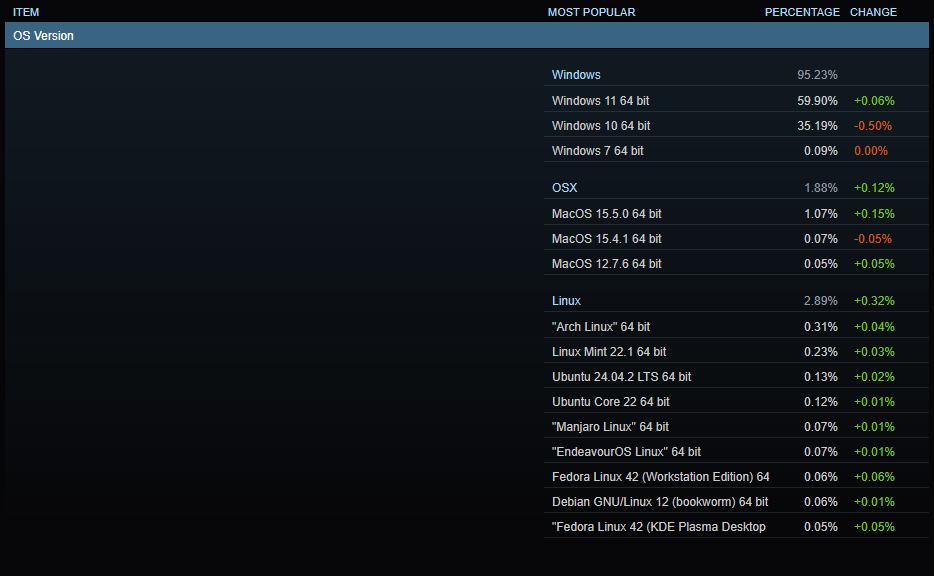AMD CPUs surpass the 40% threshold in latest Steam hardware survey — RTX 5070 emerges as the most preferred GPU within the Blackwell series
Intel’s lead shrinks as gamers increasingly embrace AMD’s 3D V-Cache CPUs

The latest Steam hardware survey data for July 2025 suggests AMD’s share of gaming CPUs has finally crossed the 40% mark. This means that roughly four in ten Steam PC gamers now run AMD CPUs. While this marks a new high for Team Red in the Steam user base, it also underscores the company's slow and steady gains. To provide some context, Intel dominated the Steam gaming market with roughly 77% of gamers five years ago, but has since fallen below 60%.
AMD’s rise can be attributed mainly to the popularity of its 3D V-Cache CPUs, including the Ryzen 7 9800X3D, which have been well-received by gamers and enthusiasts. The demand for high-performance CPUs, especially X3D models, and competitive pricing seem to be chipping away at Intel’s former advantage. This shift also means that AMD now commands a larger share of the PC gaming CPU market than it did previously.

The Steam survey also highlights the rapid adoption of Nvidia’s new Blackwell‑based GPUs. The mid-range RTX 5070 is currently the most popular GPU in the RTX 50-series, with a 1.32% market share, an increase of 0.33% from last month. This was the most significant jump for any GPU in the previous month, followed by the RTX 5060, which gained 0.26%, bringing its overall share up to 0.60%. Overall, Nvidia’s share of all discrete GPUs in Steam remains extremely high at 73.94%.
By contrast, AMD’s latest Radeon 9000-series GPUs based on the RDNA 4 architecture are yet to make an appearance on the Steam chart. The survey data show that no RX 9070 or 9060 cards exceed the reporting threshold, indicating that all RDNA 4 models are likely bundled into the “Other” category. This absence is likely due to constrained supply or slow adoption, as insiders note that AMD may not have enough new cards in gamers’ hands yet to register in the stats. For comparison, even the extremely overpriced RTX 5090 is included on the list, despite having a tiny 0.19% share. AMD’s strong new desktop GPUs, including the flagship RX 9070 XT, are popular in retail, but their impact isn’t yet visible in Steam’s latest numbers.
On the software side, the OS landscape continues to shift towards Windows 11, likely due to Windows 10’s looming EOL, with Linux gaming at its highest steady level in years. The data show that approximately 59.9% of Steam gamers are using Windows 11 (64-bit), a 0.06% increase compared to June, while Windows 10 (64-bit) has slipped to 35.19%, down 0.50%. Meanwhile, macOS usage remains under 2%, while Linux holds a substantial gain of 0.32% bringing the overall market share to 2.89%.



For system RAM, 16GB remains the most common configuration, used in approximately 42% of all PCs. However, 32GB setups are now at 35.15% which is a noticeable jump of 0.78%, confirming that high‑memory rigs are growing steadily. Graphics VRAM, or video memory, shows similar trends, as most surveyed gamers still have 8GB of VRAM, which accounts for about 33.66% of all systems. The next-largest slice is 12GB, accounting for 19.22% of all PCs, which represents the most significant jump compared to last month at 0.40%.
Follow Tom's Hardware on Google News to get our up-to-date news, analysis, and reviews in your feeds. Make sure to click the Follow button.
Get Tom's Hardware's best news and in-depth reviews, straight to your inbox.

Kunal Khullar is a contributing writer at Tom’s Hardware. He is a long time technology journalist and reviewer specializing in PC components and peripherals, and welcomes any and every question around building a PC.
-
ottonis I wonder why it took AMD CPUs so long to gain the gaming market share they achieved now. After all, since 2019, AMD has always had an advantage in price to performance ratio and was always the better pick for gaming oriented PCs, especially when on a budget.Reply
So, either AMD didn't deliver as many SKUs as they could sell, or there were still those old Intel tactics at play, bribing or even extorting large OEMs and sellers to favor Intel over AMD. -
Amdlova AMD slow adoption is because the compatibility issues.Reply
Intel other hand works with everything from 386 to a 14 gen cpu.
The gaming market is a very tiny portion of the market
I'am x86 slave... But I really wan't to step down to ARM device
Waiting for the Nvidia with the N1X or other brand =) -
Kamen Rider Blade Reply
Don't leave us.Amdlova said:AMD slow adoption is because the compatibility issues.
Intel other hand works with everything from 386 to a 14 gen cpu.
The gaming market is a very tiny portion of the market
I'am x86 slave... But I really wan't to step down to ARM device
Waiting for the Nvidia with the N1X or other brand =)
Team x86 is 4 Life! -
TerryLaze Reply
Lol no!ottonis said:I wonder why it took AMD CPUs so long to gain the gaming market share they achieved now. After all, since 2019, AMD has always had an advantage in price to performance ratio and was always the better pick for gaming oriented PCs, especially when on a budget.
So, either AMD didn't deliver as many SKUs as they could sell, or there were still those old Intel tactics at play, bribing or even extorting large OEMs and sellers to favor Intel over AMD.
The only reason amd cpus increased is the steamdeck and the subsequent rise of all the other gaming handhelds.
You can look this up if you click for details, 60% of that whole 60% is running linux and only ~40% is running windows, without that linux part amd would still be pretty low.
https://store.steampowered.com/hwsurvey/processormfg/ -
ottonis Reply
Thanks! Now I am even more confused. Why would AMD on Windows have so low counts when it's been the more sensible choice for gaming for more than 5 years?TerryLaze said:Lol no!
The only reason amd cpus increased is the steamdeck and the subsequent rise of all the other gaming handhelds.
You can look this up if you click for details, 60% of that whole 60% is running linux and only ~40% is running windows, without that linux part amd would still be pretty low.
https://store.steampowered.com/hwsurvey/processormfg/ -
stuff and nonesense Reply
Inertia, people don’t always go out and buy the latest and greatest (from whoever) straight away and AMD had to establish themselves as a good alternative. There will have been 8000, 9000, 10000, a few 11000 series CPUs still in use slowly trickling away as the 12/13/14000 series Intel stuff replaced some of those CPUs. Some people will have actively chosen to go to AMD as the 11000 and earlier chips became less attractive.ottonis said:I wonder why it took AMD CPUs so long to gain the gaming market share they achieved now. After all, since 2019, AMD has always had an advantage in price to performance ratio and was always the better pick for gaming oriented PCs, especially when on a budget.
So, either AMD didn't deliver as many SKUs as they could sell, or there were still those old Intel tactics at play, bribing or even extorting large OEMs and sellers to favor Intel over AMD.
(I hate the term) Enthusiasts will have looked up their CPU choices on reputable sites and some will have jumped ship to AMD in the light of the 13 and 14000 series degradation debacle.
Steam deck may have contributed to some degree, though I don’t know anyone who has bought one. -
Notton Reply
Because AMD is AMD and doesn't produce enough CPUs or GPUs to match what the OEMs want.ottonis said:I wonder why it took AMD CPUs so long to gain the gaming market share they achieved now.
Dell, HP, Lenovo, Asus, MSI, Gigabyte, Acer, etc. are all around 90~95% Intel CPU based builds.
That and most people don't buy a new gaming PC every year.
But it's actually a lot better for AMD than the numbers indicate, and damning for Intel.
Intel was dominating and had 80% share on steam survey for years and it's evaporated within 6 years.
Steam survey AMD CPU share.
2016: 20%
2017: 19%
2018: 16%
2019: 20%
2020: 26%
2021: 30%
2022: 34%
2023: 34%
2024: 37%
2025: 40% -
Neilbob Reply
This post legitimately made my head hurt. It makes no sense.TerryLaze said:Lol no!
The only reason amd cpus increased is the steamdeck and the subsequent rise of all the other gaming handhelds.
You can look this up if you click for details, 60% of that whole 60% is running linux and only ~40% is running windows, without that linux part amd would still be pretty low.
https://store.steampowered.com/hwsurvey/processormfg/
Imagine the whole survey was performed with just 1,000 systems. Based solely on the numbers, Linux usage at below 3% of the total (which includes the Steam Deck, remember), would be less than 30 systems.: about 18 (60%) of those would be AMD. MacOS would account for about 20. The remaining 950-ish would be Windows, and approximately 380 of those would be AMD with the other 570 being Intel. I really really doubt there are enough handheld systems represented to significantly heighten AMDs numbers here.
However you try and skew the numbers, the overall 40% AMD 60% Intel is roughly accurate (as much as the highly variable Steam survey can be).
My own comment made my head hurt. -
King_V Reply
What compatibility issues? Please cite sources.Amdlova said:AMD slow adoption is because the compatibility issues.
Intel other hand works with everything from 386 to a 14 gen cpu.
The gaming market is a very tiny portion of the market
I'am x86 slave... But I really wan't to step down to ARM device
Waiting for the Nvidia with the N1X or other brand =)